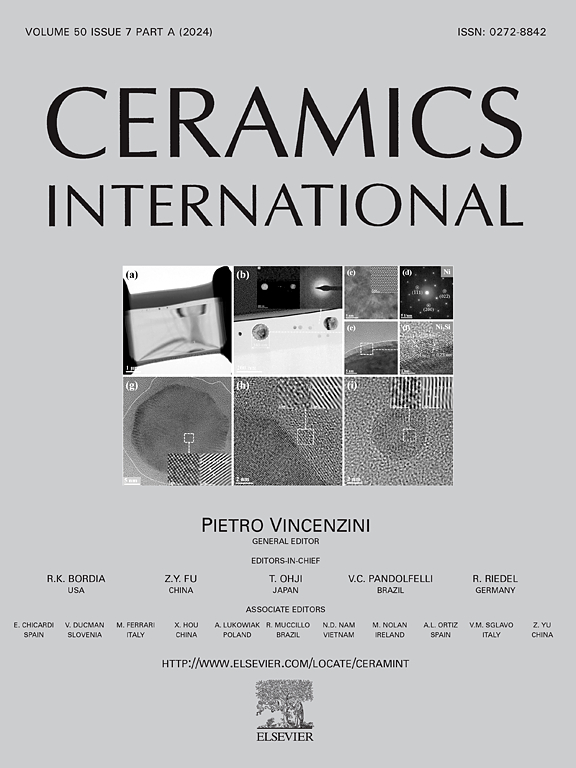用于制备陶瓷基复合材料的易于控制粘度的二硼化锆基浆料
IF 5.6
2区 材料科学
Q1 MATERIALS SCIENCE, CERAMICS
引用次数: 0
摘要
以酚醛树脂为粘结剂,丙酮为溶剂,对不同分散度的ZrB2陶瓷粉浆料的流变性能进行了全面研究。研究了酚醛树脂在丙酮溶液和含陶瓷填料的浆料中粘度和剪切应力对剪切速率的影响。确定了分散的ZrB2颗粒在浆料中的含量限制,确定了浆料的动态粘度随其组成的变化范围。提出了一个模型来描述和预测含有陶瓷填料、有机树脂和溶剂的多组分浆料的粘度值。采用不同粘度的浆料制备了连续碳纤维增强ZrB2-SiC复合材料。浆料粘度对碳纤维的渗透能力以及复合材料的整体微观结构有显著影响。本文章由计算机程序翻译,如有差异,请以英文原文为准。
Zirconium diboride-based slurries with readily controlled viscosity for preparing ceramic matrix composites
A comprehensive study of the rheological properties of slurries containing ZrB2 ceramic powder of different dispersity, as well as phenol–formaldehyde resin as a binder and acetone as a solvent, was undertaken. Dependences of viscosity and shear stress on shear rate of both solutions of phenol–formaldehyde resin in acetone and slurries containing ceramic fillers were investigated. The limits of the content of dispersed ZrB2 particles in the slurries were established, and the range of dynamic viscosities of the slurries depending on their composition was determined. A model was proposed to describe and predict the viscosity values of multicomponent slurries containing a ceramic filler, an organic resin, and a solvent was proposed. The ZrB2-SiC composites reinforced with continuous carbon fiber were formed using the resulting slurries of different viscosities. The penetration ability of the slurries into the carbon fiber, as well as the composite's overall microstructure, have been demonstrated to be significantly influenced by slurry viscosity.
求助全文
通过发布文献求助,成功后即可免费获取论文全文。
去求助
来源期刊

Ceramics International
工程技术-材料科学:硅酸盐
CiteScore
9.40
自引率
15.40%
发文量
4558
审稿时长
25 days
期刊介绍:
Ceramics International covers the science of advanced ceramic materials. The journal encourages contributions that demonstrate how an understanding of the basic chemical and physical phenomena may direct materials design and stimulate ideas for new or improved processing techniques, in order to obtain materials with desired structural features and properties.
Ceramics International covers oxide and non-oxide ceramics, functional glasses, glass ceramics, amorphous inorganic non-metallic materials (and their combinations with metal and organic materials), in the form of particulates, dense or porous bodies, thin/thick films and laminated, graded and composite structures. Process related topics such as ceramic-ceramic joints or joining ceramics with dissimilar materials, as well as surface finishing and conditioning are also covered. Besides traditional processing techniques, manufacturing routes of interest include innovative procedures benefiting from externally applied stresses, electromagnetic fields and energetic beams, as well as top-down and self-assembly nanotechnology approaches. In addition, the journal welcomes submissions on bio-inspired and bio-enabled materials designs, experimentally validated multi scale modelling and simulation for materials design, and the use of the most advanced chemical and physical characterization techniques of structure, properties and behaviour.
Technologically relevant low-dimensional systems are a particular focus of Ceramics International. These include 0, 1 and 2-D nanomaterials (also covering CNTs, graphene and related materials, and diamond-like carbons), their nanocomposites, as well as nano-hybrids and hierarchical multifunctional nanostructures that might integrate molecular, biological and electronic components.
 求助内容:
求助内容: 应助结果提醒方式:
应助结果提醒方式:


